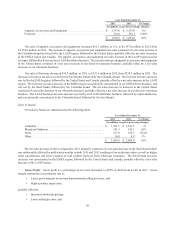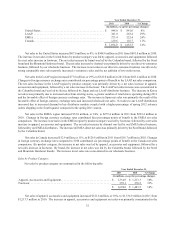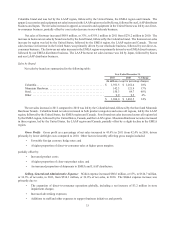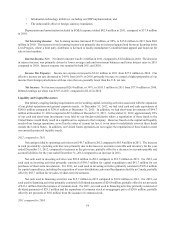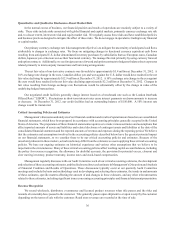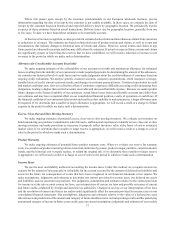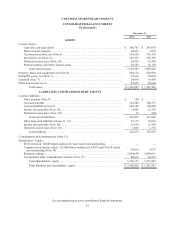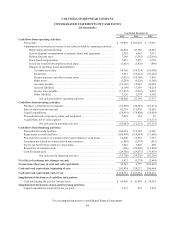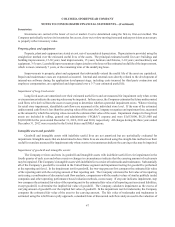Columbia Sportswear 2012 Annual Report Download - page 41
Download and view the complete annual report
Please find page 41 of the 2012 Columbia Sportswear annual report below. You can navigate through the pages in the report by either clicking on the pages listed below, or by using the keyword search tool below to find specific information within the annual report.37
Where title passes upon receipt by the customer, predominantly in our European wholesale business, precise
information regarding the date of receipt by the customer is not readily available. In these cases, we estimate the date of
receipt by the customer based on historical and expected delivery times by geographic location. We periodically test the
accuracy of these estimates based on actual transactions. Delivery times vary by geographic location, generally from one
to five days. To date, we have found these estimates to be materially accurate.
At the time of revenue recognition, we also provide for estimated sales returns and miscellaneous claims from customers
as reductions to revenues. The estimates are based on historical rates of product returns and claims, as well as events and
circumstances that indicate changes to historical rates of returns and claims. However, actual returns and claims in any
future period are inherently uncertain and thus may differ from the estimates. If actual or expected future returns and claims
are significantly greater or lower than the reserves that we have established, we will record a reduction or increase to net
revenues in the period in which we make such a determination.
Allowance for Uncollectable Accounts Receivable
We make ongoing estimates of the collectability of our accounts receivable and maintain an allowance for estimated
losses resulting from the inability of our customers to make required payments. In determining the amount of the allowance,
we consider our historical level of credit losses and we make judgments about the creditworthiness of customers based on
ongoing credit evaluations. We analyze specific customer accounts, customer concentrations, credit insurance coverage,
standby letters of credit, current economic trends, and changes in customer payment terms. Continued uncertainty in credit
and market conditions may slow our collection efforts if customers experience difficulty accessing credit and paying their
obligations, leading to higher than normal accounts receivable and increased bad debt expense. Because we cannot predict
future changes in the financial stability of our customers, actual future losses from uncollectable accounts may differ from
our estimates and may have a material effect on our consolidated financial position, results of operations or cash flows. If
the financial condition of our customers deteriorates and results in their inability to make payments, a larger allowance may
be required. If we determine that a smaller or larger allowance is appropriate, we will record a credit or a charge to SG&A
expense in the period in which we make such a determination.
Excess, Close-Out and Slow Moving Inventory
We make ongoing estimates of potential excess, close-out or slow moving inventory. We evaluate our inventory on
hand considering our purchase commitments, sales forecasts, and historical experience to identify excess, close-out or slow
moving inventory and make provisions as necessary to properly reflect inventory value at the lower of cost or estimated
market value. If we determine that a smaller or larger reserve is appropriate, we will record a credit or a charge to cost of
sales in the period in which we make such a determination.
Product Warranty
We make ongoing estimates of potential future product warranty costs. When we evaluate our reserve for warranty
costs, we consider our product warranty policies, historical claim rates by season, product category and mix, current economic
trends, and the historical cost to repair, replace, or refund the original sale. If we determine that a smaller or larger reserve
is appropriate, we will record a credit or a charge to cost of sales in the period in which we make such a determination.
Income Taxes
We use the asset and liability method of accounting for income taxes. Under this method, we recognize income tax
expense for the amount of taxes payable or refundable for the current year and for the amount of deferred tax liabilities and
assets for the future tax consequences of events that have been recognized in our financial statements or tax returns. We
make assumptions, judgments and estimates to determine our current provision for income taxes, our deferred tax assets
and liabilities, and our uncertain tax positions. Our judgments, assumptions and estimates relative to the current provision
for income tax take into account current tax laws, our interpretation of current tax laws and possible outcomes of current
and future audits conducted by foreign and domestic tax authorities. Changes in tax law or our interpretation of tax laws
and the resolution of current and future tax audits could significantly affect the amounts provided for income taxes in our
consolidated financial statements. Our assumptions, judgments and estimates relative to the value of a deferred tax asset
take into account predictions of the amount and category of future taxable income. Actual operating results and the underlying
amount and category of income in future years could cause our current assumptions, judgments and estimates of recoverable





